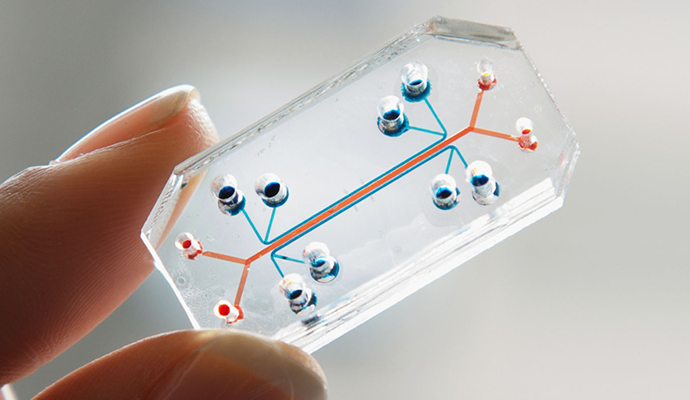
Vivisection involves more than 100 million animals globally every year who are subjected to an on-going horrific nightmare of painful tests and experiments for cosmetics, drugs, food, disease cures, medical training and curiosity-driven medical experiments at universities. None of them receive anaesthesia or pain relief and just about all of them are then killed afterwards.
The exact numbers of animals used in laboratories aren’t available because mice, rats, birds, and cold-blooded animals—who make up more than 95% of animals used in experiments—are not covered by even the minimal protections our laws, and therefore go uncounted.
It is a morally bankrupt society that exploits and abuses vulnerable animals only to forward their own longevity, but there are a few people out there who are working to produce accurate models and resulting testing methods which do not involve animals at all.
3D Bioprinting
Additive manufacturing, otherwise known as three-dimensional (3D) printing, is driving major innovations in many areas, such as engineering, manufacturing, art, education and medicine. But more recent advances have enabled 3D printing of biocompatible materials, cells and supporting components into complex 3D functional living tissues which could mean the end to animal testing.

The increasing sophistication of 3D printing is shown in an ear that melds biological and electronic parts.
There are a number of complexities with 3D bioprinting. When compared with non-biological printing, complexities like the choice of materials, cell types, growth and differentiation factors and technical challenges related to the sensitivities of living cells and the construction of tissues have to be addressed. This requires the integration of technologies from the fields of engineering, biomaterials science, cell biology, physics and medicine.
3D bioprinting has already been used for the generation and transplantation of several tissues, including multilayered skin, bone, vascular grafts, tracheal splints, heart tissue and cartilaginous structures. Furthermore, high-throughput 3D-bioprinted tissue model applications can be developed for other areas of disease research and drug development.

Although surgeons are already using 3D-printed metal and plastic implants to replace bones, researchers are looking ahead to printing organs using cells as “ink”. The structures shown here were all 3D printed and include a rudimentary proto-kidney (top left), complete with living cells.
Chips
Dubbed organ-on-chip devices, these miracle devices will play a vital role in the end of animal testing, while revolutionising the development of new drugs and potentially ushering us into a future of entirely personalised medicine.
Chips that are lined with living human cells mimic the tissue structures and mechanical motions of human organs. The lung-on-a-chip is a simulation of the biological processes inside the human lung which was developed by the Wyss Institute for Biologically Inspired Engineering at Harvard University.
The micro-devices recreating the tissue interfaces of human organs inside a transparent polymer chip. A tiny channel runs through the middle, dividing along its length by a porous membrane, with human lung cells on one side and blood capillary cells on the other.

This humble chunk of see-through silicone is a model organ that could revolutionise the pharmaceutical industry.
By running air through one side and a blood-like solution through the other, while applying a flexing and stretching motion using a vacuum, the chip can simulate the processes of breathing. The behaviours of bacteria, drugs and human white blood cells can easily be monitored through a microscope.
We now have a window on the molecular-scale activities going on in human organs, including things that happen in human cells that don’t occur in animals. Most drug companies get completely different results in dogs, cats, mice and humans, but now they will be able to test the specific effects of drugs with greater accuracy and speed.
— Don Ingber, the Wyss Institute.
The team at the Wyss Institute have developed a number of different organs-on-chips to date, including a kidney, liver and peristaltic gut-on-a-chip, while skin-on-a-chip is currently in development for the cosmetics industry and for testing household cleaning products. The different organs can also be joined up in a network, allowing the journey of a drug to be followed through a simulated human body.
Organ-on-chips look to promise an end to animal testing by accelerating drug discovery, decreasing the development costs and potentially bringing in a future of personalised medicine.
Moving Forward
Animals are a completely different bio-mechanical entity to humans. The anatomical, physiological, immunological, histological and even psychological differences between humans and animals are too great to overcome and currently, there is no formula for making animal-derived research consistently and reliably relevant to human health.
Throughout the last 150 years in which animal testing has been conducted and the trillions of animals who have been barbarically and selfishly sacrificed, for the first time there are actually applicable models and formulas being made available for the development and testing of disease research, drug discovery, toxicology, and tissue and organ transplantation.
The future of 3D bioprinting tissue and organs means an end to animal testing where xenotransplantation, or cross-species transplantation, would no longer need to be attempted in all of its barbaric fashion.
Countless animals have been used and torn apart in an attempt to support research and practices involving blood transfusions from various animal species into human patients for pathological conditions, skin graphs where frogs were the most popular, primate organ transplantations with techniques involving blood vessel anastomosis, and the genetic engineering and cloning of pigs with attempts to protect tissues from the human immune response to result in pig grafts.
With the incredible potential of organ-on-chip human body networks, the testing of cosmetics, chemicals, drugs, food products and disease research would no longer be carried out on billions of live animals who suffer immensely. What we would see instead are relevant and consistently reliable results to human anatomy and physiology.
Sources: Nature, NCBI Animal Organs for Human Transplants, NCBI History of Cross-Species Transplantation, Lung On A Chip, The Guardian: Chips,

